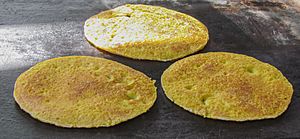Cachapa facts for kids
 |
|
| Type | Pancake |
|---|---|
| Place of origin | Venezuela |
| Main ingredients | Ground corn |
A Cachapa is a yummy, traditional dish from Venezuela. It's like a sweet pancake made from fresh corn. You can often find them sold at roadside stands, just like arepas.
Cachapas are usually made from a thick batter of fresh ground corn. This batter is cooked on a special flat griddle called a budare. Because of the corn kernels, cachapas are a bit thicker and lumpier than regular pancakes.
People traditionally eat cachapas with queso de mano. This is a soft, mozzarella-like cheese made by hand. Sometimes, they also add crispy fried pork called chicharrón on the side. Cachapas can be simple or fancy, with different cheeses, cream, or even jam. They can be a tasty appetizer or a full breakfast!
What's in a Name?
Cachapas have different names in other countries. In Colombia, they are called arepas de choclo. This means "corn arepas." In a region called the Llanos Orientales, they are known as arepas de maiz jojoto or tierno, which means "soft corn."
In Costa Rica, a similar dish is called chorreadas. This name comes from the word "squirts" because the batter is quite liquid before it's cooked. Costa Rican chorreadas often have a bit more sugar and vanilla. They are usually served with eggs and Gallo pinto for breakfast.
In Venezuela, restaurants that sell cachapas are sometimes called "cachaperas."
A Sweet History
Cachapas have a very long history in Venezuelan cooking. They first appeared in pre-Columbian times, even before Christopher Columbus arrived. Back then, native people would grind corn using stones and cook it over fires.
Many believe cachapas came from tribes like the Chaima culture. Others think this dish dates back 500 to 1,800 years ago, to tribes like the Yanomami, Arawak, and Parias. The north-central part of Venezuela was famous for growing sweet corn. They used it to make cachapas for special events.
Today, you can buy cachapas already made, or go to a restaurant. But many locals love to eat them as street food. They believe homemade ones are the best! Over the years, cachapas have changed. They can even fit special diets, like vegetarian or gluten-free.
Corn is still very important in Venezuelan food. Sweet corn is used in many main dishes, like arepas, empanadas, and cachapas. You can find cachapas everywhere, from street food trucks to fancy restaurants. This shows how popular and important they are in the country.
Modern cachapas are often fried. People add salt and sugar to make them taste even better. Today's cachapas are made with corn, milk, salt, water, and sugar. Restaurants have also added fillings like roasted pork and queso de mano. Some people even use canned or frozen corn now to make them faster and easier.
What They Look Like
Cachapas are usually folded in half with lots of butter and your favorite filling inside. They have a slightly crispy outside. The inside is soft and tender, like a pancake. But cachapas are yellowish because of the cornmeal. This helps you tell them apart from regular American pancakes.
How to Make Them
To make the batter, you mix corn, sugar, eggs, milk, salt, cornflour (like Harina P.A.N), and melted butter. You can do this in a food processor. Then, you pour the batter onto a non-stick skillet, shaping it like a pancake. Cook each side for about 4 to 5 minutes. After that, you can enjoy your cachapa with your favorite toppings and meats!
See also
 In Spanish: Cachapa para niños
In Spanish: Cachapa para niños


